How Much To Start A Blog On Wordpress
Learn how to start a blog in 7 easy steps. Follow this step-by-step guide to discover the tactics I used to make $1 million with my blog in under two years, reach more than 500,000 monthly readers, and be featured in Forbes, Entrepreneur, and Business Insider.
How to Start a Blog in 7 Easy Steps:
- Set up your blog.
- Choose your blog's niche.
- Install WordPress.
- Choose your blog's theme.
- Install some easy WordPress plugins.
- Create great content
- Promote your blog
Let's get started.
1. Set Up Your Blog
Here's my favorite beginner setup at the lowest cost with the best features (based on my 10+ years of experience):
- Click here to go to Bluehost.com (<- that link gets you a discount) and click Get Started Now.
- Choose the Choice Plus Plan.
- Enter the domain name you want to use (i.e. adamenfroy.com).
- Enter your account information.
- Under Package Information, choose an account plan based on how long you want to py. (Remember, there's a 30-day money-back guarantee with all plans, so no risk!)
- Uncheck the Package Extras (you don't need them.)
- Complete your purchase, choose your password, and login to your Bluehost account.
- Answer the onboarding questions or skip them, but choose "blog" when prompted.
- Click "skip" when it comes to choosing your theme. (We'll get that sorted out later.)
- From the Bluehost dashboard, click the WordPress button on the top right and you'll be taken to WordPress.
Congrats! You now have a self-hosted WordPress blog! 😀
Here are some other things to consider when choosing a domain name:
- Your name should be memorable and not too difficult to type.
- Don't confuse people with difficult spelling, so keep the name easy to spell and pronounce.
- Avoid using numbers and hyphens in your domain as it can confuse people.
- Keep your name a little bit broad in case you need to pivot to an adjacent niche.
2. Choose Your Blog's Niche.
We all know that your blog needs a niche.
Whether it's marketing, cooking, Crossfit exercises, vegan dogsitting, underwater parkour solo dancing – whatever crazy blog topic, there are an endless amount of things to blog about.
Here's the problem:
Most professional bloggers will tell you to start with something that you're passionate about because it helps you "maintain a consistent writing schedule and push through failure to succeed."
They'll also tell you to choose a niche at the intersection of passion, skills, and experience:
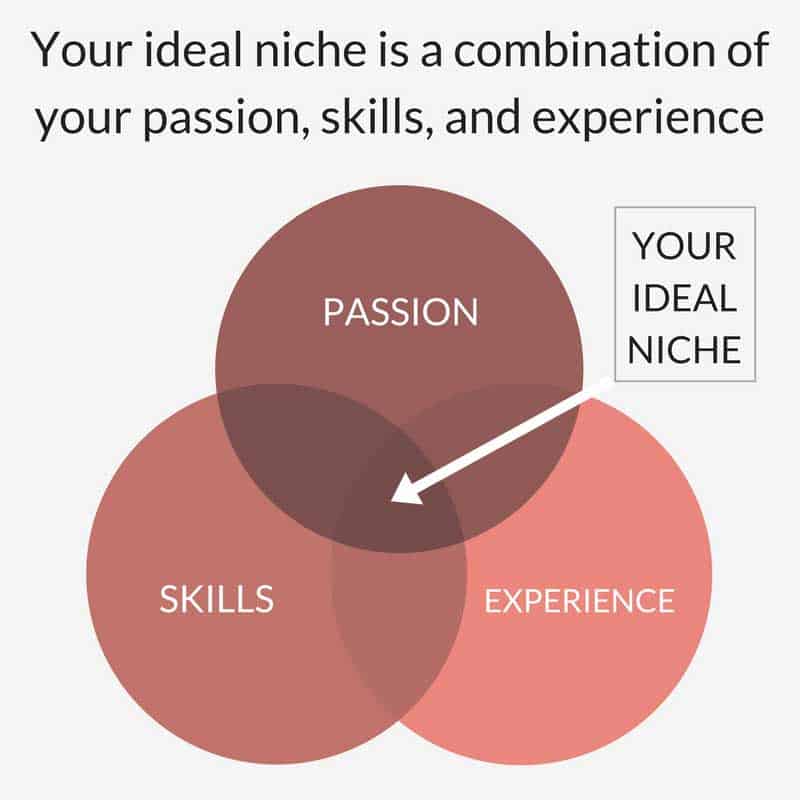
Source: mintnotion.com
However, if you're starting a blog to make money (read my blog income reports), this model is flawed because it's missing one major component: the brand of you.
As a blogger, you are the brand.
When choosing your niche, think about:
- What you want to teach.
- Where you may already have experience.
- Any leverage you may have in an industry.
- Where you can extract value from the market.
In my premium blogging course, Blog Growth Engine, we teach a concept called "The Authority Flywheel".
This is a detailed flywheel exercise that looks something like this:
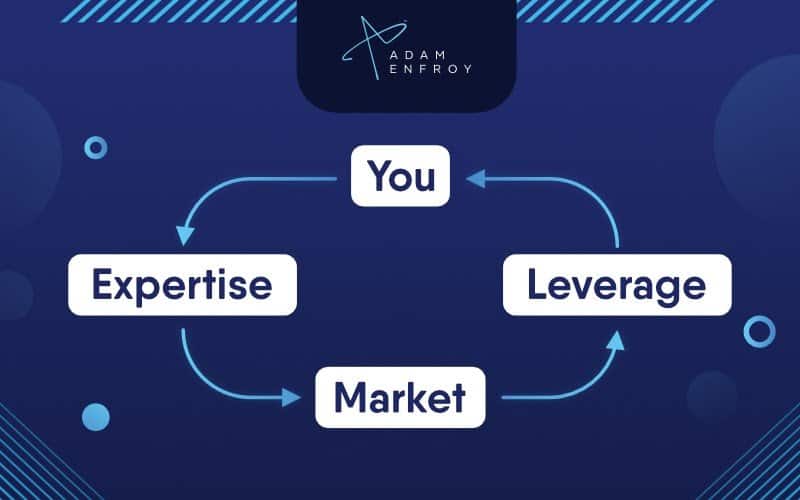
It has four parts starting with "You" because your niche is based on you first and foremost; your life is your niche.
The next step is uncovering your expertise. Not what you think you are an expert at or want to be an expert at but what you have a proven track record of succeeding at. Your expertise is what enables you to make money with a new blog.
The third step is taking an honest look at the market.
Ask: How can you monetize this market? Just because you're passionate about this niche doesn't make it the right niche for you.
And last but not least is the leverage you have in your life.
Here are some questions to ask yourself: What levers can you pull? Do you have connections? Insider information on a market? An incredible skill set compared to most people?
How are you uniquely positioned to leverage any and everything in your life that others wouldn't be able to keep up with?
I am completely confident that The Authority Flywheel is bulletproof when it comes to choosing your niche and starting a blog that actually works.
Disclaimer: This post includes affiliate links that may provide a commission to me at no cost to you if you purchase a paid plan. However, the links are for the best software and tools you need to start a successful blog. For more information, you can read my affiliate disclosure in my privacy policy.
3. Start a Blog By Installing WordPress
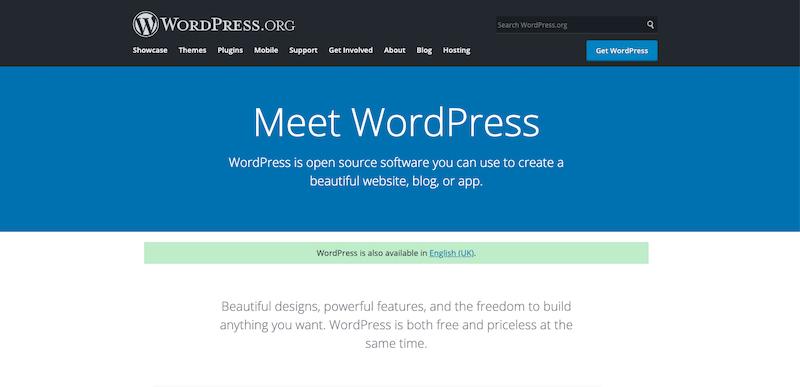
Self-hosted WordPress is the best blog platform for new bloggers.
The good news? Bluehost automatically one-click installs WordPress right from your hosting dashboard making starting a blog a piece of cake.
One of the first steps to creating a blog is to pick your theme.
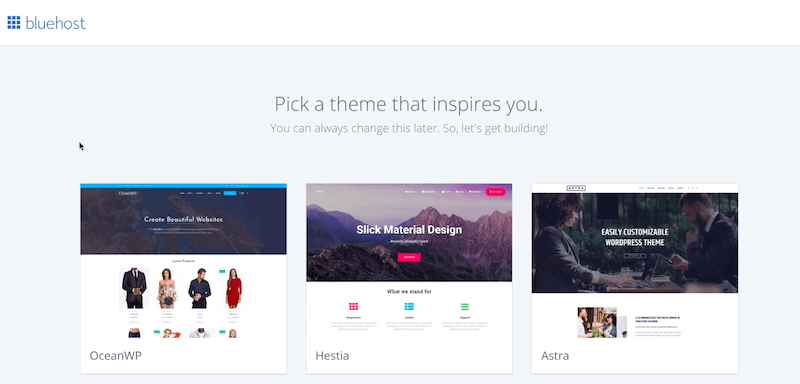
There are plenty of attractive free WordPress themes to choose from, including free blog themes.
However, if you want to pick your theme later, you can skip this step for now by clicking on the "Skip This Step" option at the end of the page.
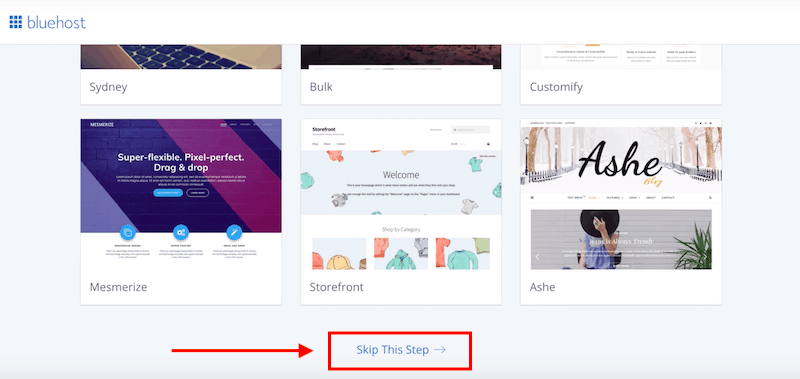
From here, you're directed to a new page where you need to click on the "Start Building" option.
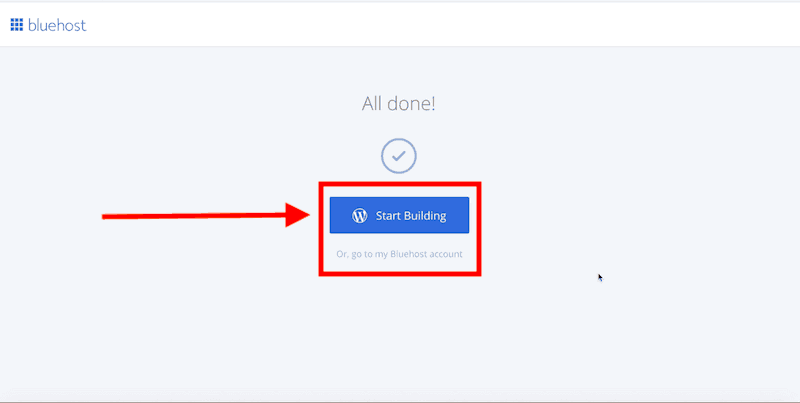
Next, select what type of site you plan to create, and WordPress will help you with prompts. You can also just click "I don't need help" to go right to your dashboard.
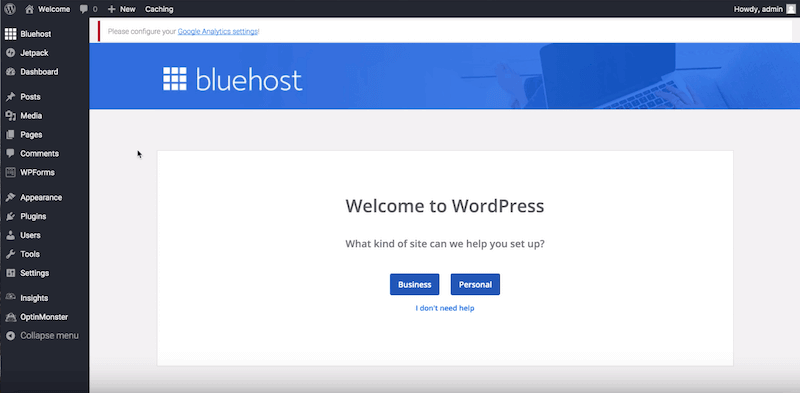
Finally, enter your "Site Title" and your "Site Description."
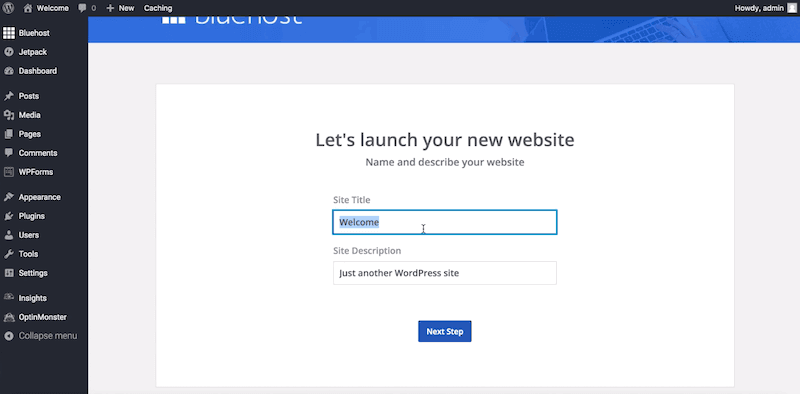
From here, spend some time making yourself familiar with the WordPress dashboard.
This brings us to our next step – choosing a theme for your blog.
Are you ready to start your blog? Get started for just $2.95/month (63% off your hosting plan) with my link below:
4. Pick a Theme for Your WordPress Blog.
A WordPress theme is a collection of templates, files, and stylesheets that dictate your blog design.
Right now, your blog might look something like this:
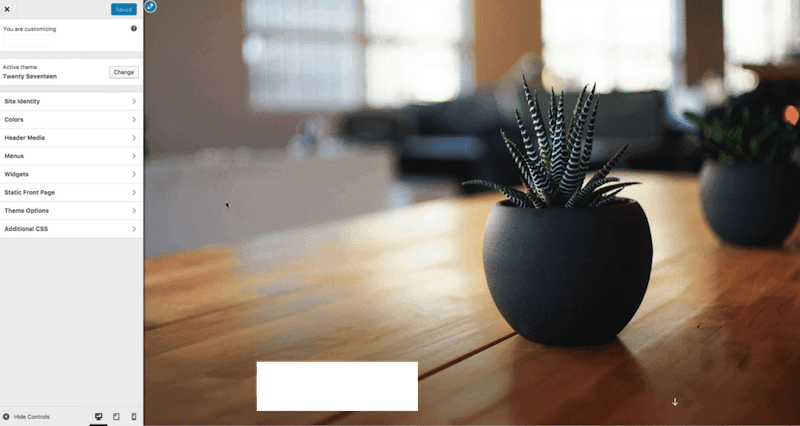
This is the default WordPress theme, and on the left side is a menu that helps you change its appearance.
Now, there are two options when it comes to themes:
You can either get a free theme with limited options or go with a paid theme.
I recommend you pick a theme from ThemeIsle to get a nice looking theme for your blog.
Here's how you can install a new theme for your WordPress blog:
First, log in to your WordPress account (admin page).
You can always access your WordPress login page by going to yourdomainname.com/wp-admin.
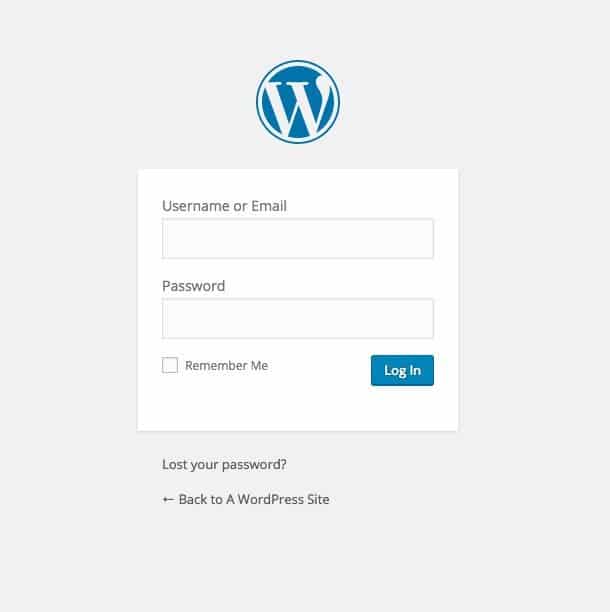
Once logged in, your WordPress dashboard looks something like this.
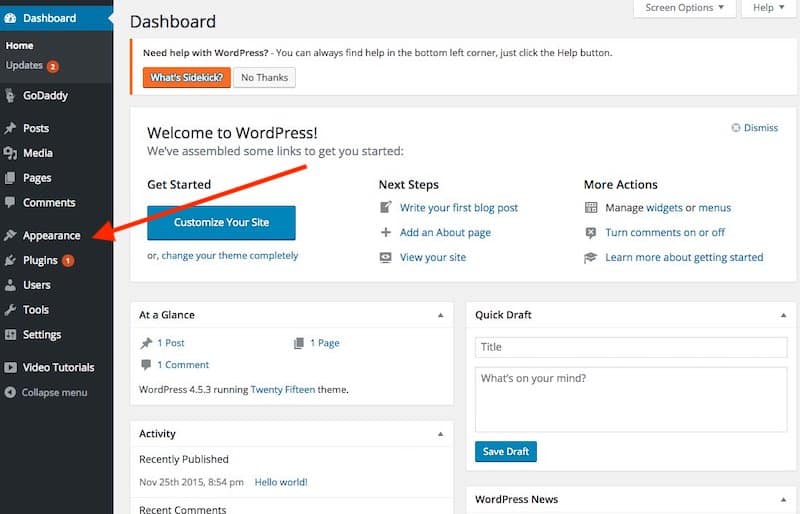
Here, click on the "Appearance" option from the sidebar menu.
Next, select the "Themes" option from the "Appearance" section.
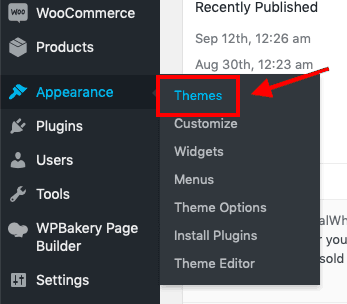
To search for the theme options WordPress offers, click the "Add New" button at the top of the page.
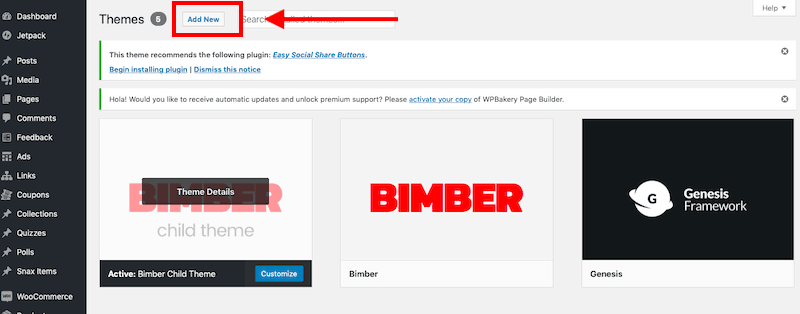
As you can see below, there are a ton of free themes to choose from.
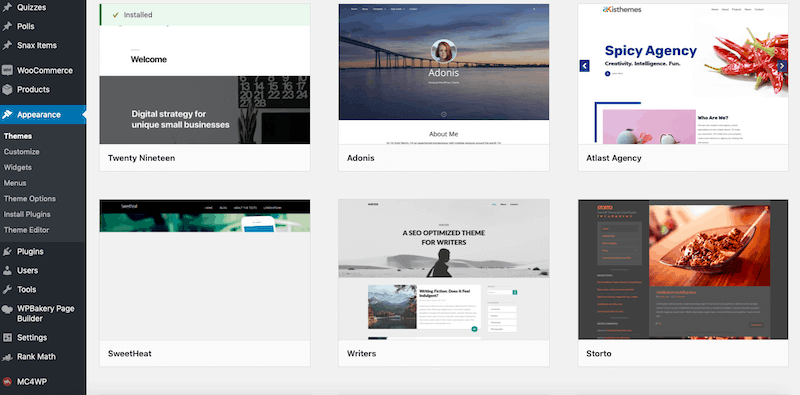
You can scroll down and preview as many WordPress themes as you want before picking one for your blog.
To install an external theme from a site like ThemeIsle, go to "Appearance" – "Themes" and click "Add New," upload the zip file, and click install.
Done.
Ready to launch your blog and follow along with this guide? Get started for $2.95/month and get 63% off your blog hosting plan:
5. Install a Few Simple WordPress Plugins.
Plugins are sets of tools that integrate with your website and extend its features.
When starting a blog, it's important to choose the best ones for SEO and site speed.
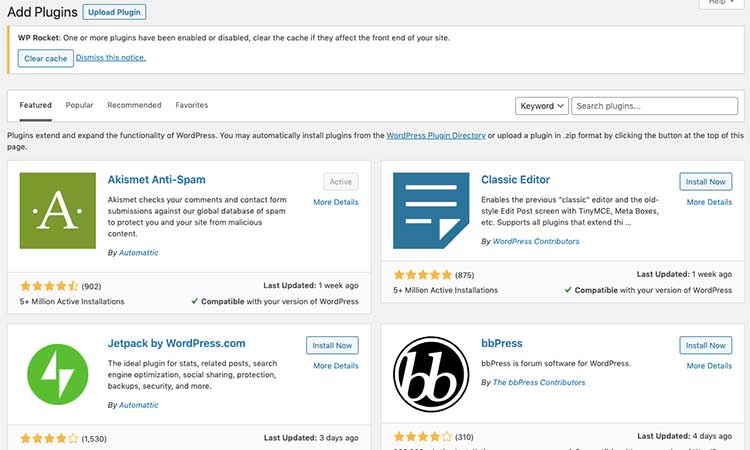
Here's a list of four of the best ones you should add to your blog:
1. Elementor Pro.
Elementor Pro is a WordPress landing page builder, and it's the tool I used to create my home page and about page. They have a free version of Elementor, but the Pro version takes it to the next level with much better templates.
2. ShortPixel Image Optimizer.
ShortPixel compresses all of your images so that they are smaller files and your pages load faster. I've tested lots of different image compression tools, and ShortPixel has been the best.
3. WP Rocket.
WP Rocket is an all-in-one site speed plugin that can do everything from minifying HTML, CSS, and JavaScript, integrate with your CDN, reduce database bloat, and more. I've tried other speed tools like Autoptimize and had some issues with it. WP Rocket is the best, in my opinion.
You can get started with WP Rocket for $49/year.
4. Yoast SEO.
I use Yoast SEO to manage my sitemap, robots.txt, page title, and meta descriptions.
6. Create Great Content for Your Blog.
Congrats! You started a blog and are ready to start blogging. This is where the rubber meets the road.
One thing first:
Blogs are no longer places where you simply write updates and gain a following.
They are now Google-driven websites that require organic search traffic.
Each blog post should focus on one main target keyword, and here's where it should be included:
- Put the keyword in your blog's permanent URL.
- Include the keyword in the title of your post.
- Add your keyword to the first or second paragraph.
- Include the keyword inside of your headings.
- Add the keyword throughout your blog post.
You'll see in my example below, the target keyword is in the title, URL, and first paragraph.
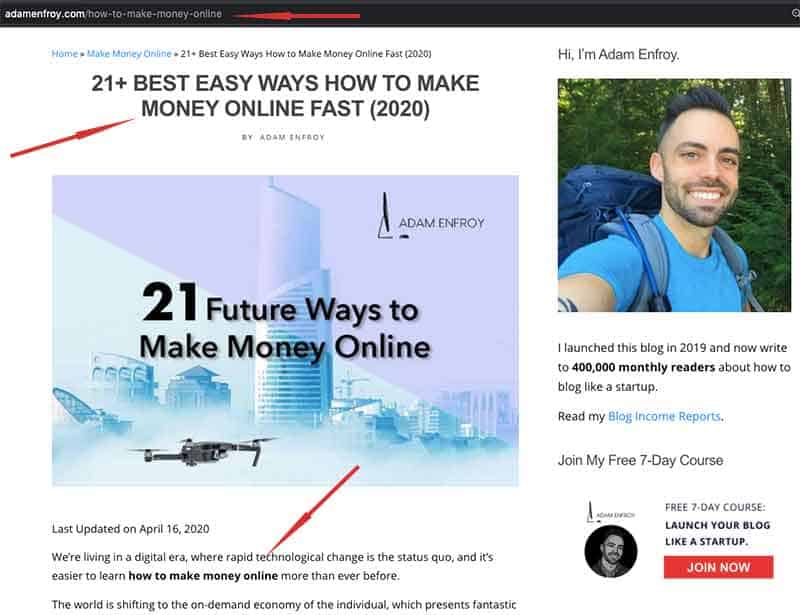
Once you have a list of the top 5-10 keywords (topics) you want to cover, it's time to start writing.
Remember, in addition to text, blog posts that have audio, video, photos, infographics, and other types of visual content perform the best and keep readers engaged.
It's also essential to write content that matches Google search intent and compels them to take action on your blog.
Writing Blog Posts that Match Search Intent.
When planning your content strategy, think about what your reader actually wants when they are performing an online search for your target keyword.
For example, let's say your target keyword is "How to Get Rid of Pimples."
When you search for this term, you'll see that a lot of blog posts feature titles including extra terms like Fast, Overnight, Quickly, and Home Remedies.
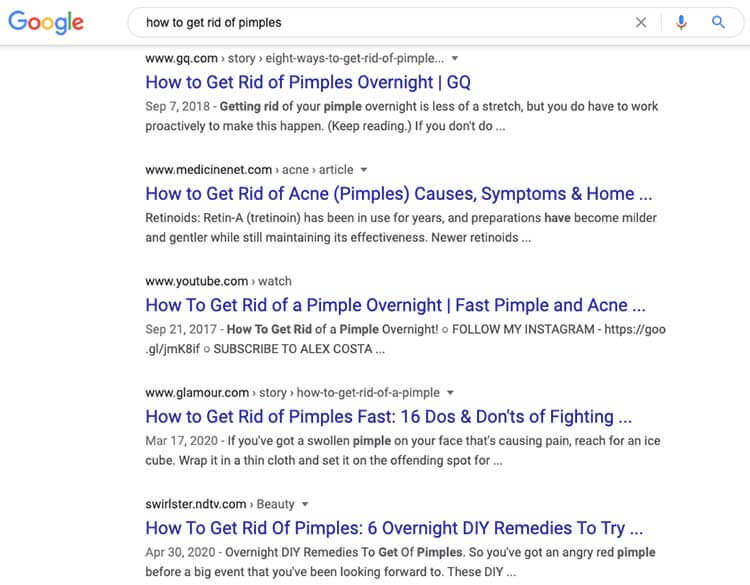
This shows that most people that want to get rid of pimples want them gone as quickly and discreetly as possible. And Google's PageRank is pushing these articles to the top.
What does this mean for your content strategy?
You should get right to the point and offer a list of the best ways to get rid of pimples fast.
Don't write a long post about "The Ultimate Guide to Getting Rid of Pimples." And don't start your post with the heading "What Are Pimples?" like many SEOs did in the past.
Instead, match search intent and provide the solution your readers are actually looking for by understanding the meaning behind their search.
This is accomplished by looking at which extra terms are included in currently ranking content's title tags and reverse-engineering the search.
While you don't have to be a professional writer when starting a blog, it's important to understand basic sentence structure and proper grammar.
For example, short paragraphs, bullet points, and images help break up long, monotonous blocks of text and keep readers engaged.
You can also check out my guide to the best grammar checkers to use with your blog this year and why I use Grammarly.
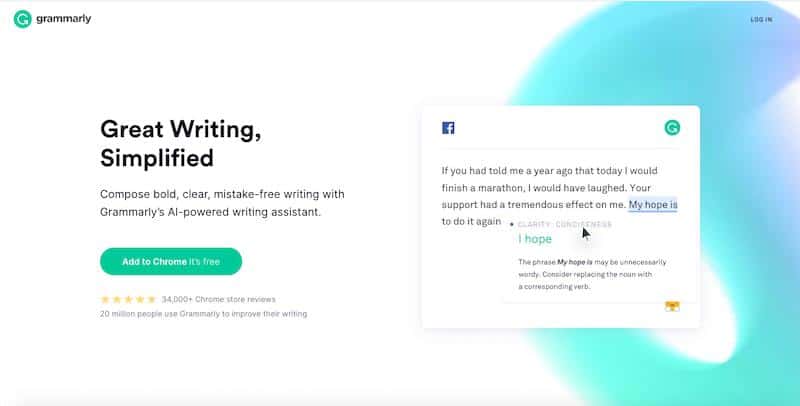
Extra Tips to Improve Your Writing.
- Your blog posts should always provide value to your readers. Write with a clear beginning, middle, and end outline structure. Even the most mundane of topics can be made interesting if you understand story arcs and hero's journeys.
- Present your blog content attractively and make it easily accessible to your readers. Make sure both textual and visual content in the blog are high-quality.
- Format your headings correctly with H2 and H3 tags, and use bulleted lists and images to break up long lines of text. No paragraph should be longer than 3-4 sentences.
- Make your first blog posts conversational to build a connection with your audience.
- Use readable fonts and use white space to keep your blog posts easy on the eyes.
- Add bullet points to help readers skim down the blog without missing anything critical.
- Double-check for typos and grammatical errors.
- Bold some text to make it stand out.
Remember, a blog is a living thing that can be updated over time. So don't try to make your content perfect – just publish it without fear and update it later.
If you haven't started your blog yet and are ready to go, get started for just $2.95/month (63% off):
Create Your Home and About Pages
Before starting a blog, you should have a few pages in your blog's top menu navigation so that readers quickly understand your blog and find important information.
In my blogging course, Blog Growth Engine, I cover extensivley the pages that you need to launch your blog and get started off on the right foot. I call them "Your Core Four" pages and they are:
1. Home Page.
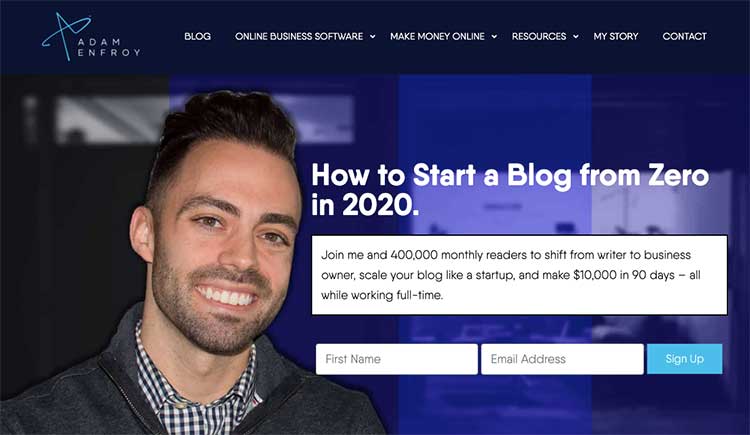
We all know what a home page is – it's the main URL of your website.
This page shouldn't include every little detail about your site – its purpose is to sell your unique value proposition in two seconds or less.
If a reader hits your home page and doesn't quickly understand what your site is about, they may bounce and never return.
A WordPress home page can be edited with a WYSIWYG (what you see is what you get) page builder like Elementor.
This tool allows you to drag-and-drop content blocks, including text, images, videos, color blocks, and more.
A good home page should contain:
- A slider or hero image with a headline and subheadline.
- A small section to tell readers more about what your blog is about.
- The main call-to-action button taking readers to an important page, post, or email list opt-in form.
- Internal links pointing to your important content to make it easy for readers to navigate around your site.
2. About Page.
The About Page of your blog should cover everything about you – who you are, what you stand for, and what your blog is about.
This section will help you connect with your readers on a deeper level, so don't hold back.
Make sure to write about:
- Who you are.
- What made you decide to start your blog.
- Your expertise or background to build trust with your readers.
- The pain point you're solving and how you've dealt with the same struggles as your audience.
- Your success story.
- A call-to-action.
To keep readers engaged, I wrote my About page like a story.
I start with how I battled self-doubt to starting a blog and turning it into a profitable business:
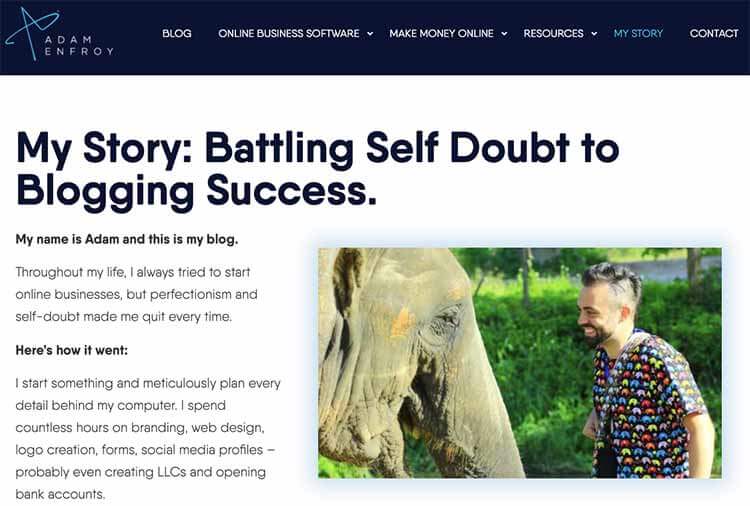
People don't necessarily want to read about all of your recent professional accomplishments.
This isn't the time to brag about yourself, but to allow people to understand who you truly are.
You can check out my About Page here.
3. Blog Post Template
Your blog post template page is fundamental when it comes to starting a blog. Your blog mostly consists of posts and you need to have this template dialed in before you start publishing posts.
Your blog posts need to be:
- Easy to read text by making sure you use large enough font in black with a white background. (Do NOT break this rule 🙂)
- Your text should be no wider than 850px. Once you start going beyond this your readers have to look too far from left to right making it difficult to read.
- They need to have proper line spacing. If you take this post you are reading right now for example you will notice that I have no more than three lines of text before a paragraph break.
Those are the main points you need to address but one thing that is also super helpful when starting a blog is looking at sites you want to model (not copy) and reverse engineer what they are doing.
This is true for every area of your blogging business, but especially in the blog post design.
4. Blog Archive
Every blog has a "/blog" page like Adamenfroy.com/blog and your blog shouldn't be the exception here.
Note: A current trend in blogging is to use a more complicated page structure but if you are starting a blog from. scratch I would make sure to have a standard /blog archive page that displays your posts in chronological order.
A good rule of thumb to follow here with this page is to make sure that it is simple and displays no more than 10 posts per page. With WordPress this site is setup by default and with almost every single theme will be automatticaly installed.
The same advice applies here as above, you want to model (not copy) sites in your niche that are getting great results.
Plan Your Future Content
Another common question I get asked is how to prioritize new blog post ideas.
This should be based on keyword metrics, including search volume, difficulty scores, and how well you think you can rank for a keyword.
You can keep track of this inside of a simple spreadsheet with columns for your future posts, including:
- Target keyword.
- Blog post title.
- Monthly search volume.
- Word count.
- Priority.
Analyze Your Content
You absolutely need to use analytics tools to analyze your content's performance.
Tools like Google Analytics and Ahrefs do this well. Since Google Analytics should already be installed on your blog, you can go to your GA dashboard to view metrics like site visitors, average time on page, total page views, and tons of other interesting stats.

You can view traffic to individual blog posts over any time period and compare it to previous periods to see if your traffic is increasing or decreasing.
Additionally, Ahrefs is the best search engine optimization (SEO) tool to track your blog post's rankings and inbound links. You can view the keywords you're ranking for, which sites are linking to you, and a lot more.
Ready to take the leap? Start your blog for just $2.95/month with Bluehost today.
Disclaimer: Please note that this post includes affiliate links that provide a commission to me at no cost to you. However, the links are for the best software and tools you need to start a successful blog. For more information, you can read my affiliate disclosure in my privacy policy.
7. Promote Your Blog
To promote your new blog, the best strategy is to do whatever it takes to build links to your blog.
Links are like the currency of the Internet.
The more you have, the more Google will take you seriously and rank all of your new blog posts.
Here are the top strategies to promote your blog:
Guest Blogging
Guest blogging is one of the best ways to promote your blog.
It's a great way to build authority in your niche, meet other bloggers, and get backlinks.
This is a hustle that includes cold email outreach and relationship building.
First, don't think about the benefits you'll get from backlinks. You have to provide value to others.
This bears repeating:
In the world of Internet marketing, you need to provide value.
For a full rundown of this strategy, read my guide on how I wrote 80+ guest posts in one year and grew my traffic to 500,000 monthly readers.
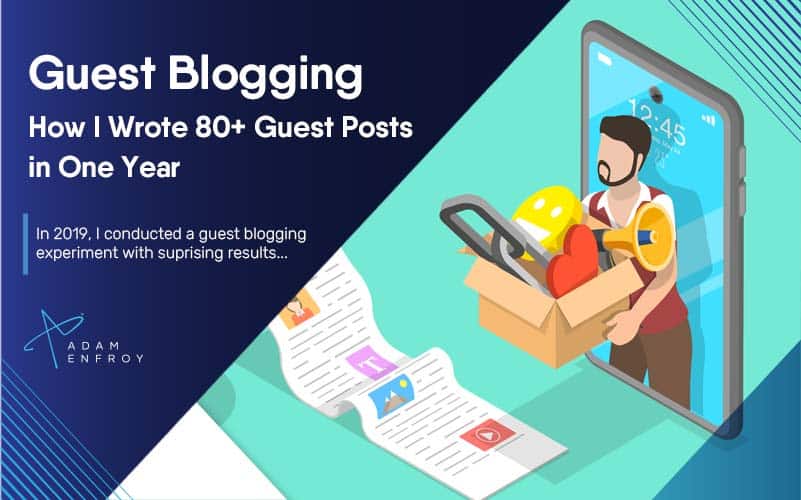
Link Building
Although guest posting is one strategy to get links to your blog, there are plenty of others.
First, the best form of link building is passively getting links without any involvement or outreach.
Sounds like a dream, right?
People naturally link to the best content they can find. So how do you make sure your blog posts are "linkable"?
When you're starting a blog, your content needs to be unique and high-quality. That's the basic entry fee to get into the game.
To take it to the next level, add visual elements to your blog posts. These can be infographics, videos, case studies, statistics, and any other unique content that doesn't exist anywhere else.
Here are some other link building strategies to try out after you set up a blog:
- Broken link building: Use a tool like Ahrefs to find blogs in your niche with broken external links. Send them an email that their link is broken and your resource is a better option. This strategy is great because you're helping the blog fix their 404 error and (hopefully) getting a link at the same time.
- Link reclamation: Input your blog's URL into the Ahrefs Content Explorer tool to find instances where your brand is mentioned but not linked to. Here, you can reach out to the writer of the post, thank them for the mention, and ask if they can add the link.
- Link partnerships: Form relationships with other bloggers in your niche to get links in their guest posts and vice versa.
- Competitor research: View which websites are linking to competitors to come up with new sites to reach out to.
If you're interested in more next-level ideas, check out my new guide to link building.
Starting a Blog: Summary
As you can see, starting a blog is pretty easy.
To recap, the 7 steps are:
- Choose a niche.
- Pick a blog name and web hosting.
- Install WordPress.
- Picking your blog's theme.
- Install WordPress plugins.
- Create great content.
- Promote your blog.
However, making your first blog successful is hard work.
To read more about starting a blog, check out my other guides:
- How to Make Money Blogging
- Things I Wish I Knew Before I Started a Blog
Now, it's your turn. Why not start a blog today?
Start a blog now with Bluehost and get 63% off your hosting plan ($2.95/month).
How to Start a Blog: Infographics

Feel free to post this infographic to your own blog! Just please make sure to add a link back to my blog as the source. 🙂
I also conducted my own research to understand the biggest challenges for new content marketers based on the stage of their blog's growth. Here's what I found:

How to Start a Blog: FAQs (Frequently Asked Questions).
1. What is a Blog?
A blog is a regularly updated website, run by an individual or group, primarily consisting of written text in an informal, conversational style.
If statistics are anything to go by, in the United States alone, 42.23% of people from the ages of 18 to 49 read blogs.
You can find a blog for any topic you want. For bloggers, it's a great avenue to increase their subscriber base, connect with new people, and make money online.
2. Why Should You Start a Blog?
There are so many reasons to start a blog.
One of the most prominent reasons is to influence and inspire online readers. If you have in-depth knowledge in your field of work and have decent writing chops, then you truly can help others. If you know how to monetize your blog, you can even make a decent passive income.
Blogging can provide you the perfect platform to:
– Develop yourself personally
– Improve your writing
– Build new relationships and network in your field
– Share your knowledge with your audience
– Make a lot of money
Speaking of money – this blog launched in 2019 and now makes over $100k/month.
3. How Much Does it Cost to Start a Blog?
When you start a blog, you have the option of using a free or paid blogging platform. Both have their pros and cons.
If you're a novice and want to try your hand at blogging without paying upfront, WordPress.com and Blogger are excellent free platforms that let you do just that. However, there are always restrictions with a free tool. For example, you won't have access to better themes, restriction on advertisements, and more.
On the other hand, if you're a seasoned campaigner or a novice confident enough about blogging, you could opt for paid platforms.
Website builders like Squarespace and Wix provide excellent paid plans that help you customize your site the way you want without restrictions. Moreover, such platforms allow you to optimize your site for search engines, add advanced features like an online store, drag-and-drop editors, and more.
Here are some of the essential expenses:
– Domain name: It may cost you around $10 per month
– Hosting: Shared hosting cost typically costs $3 – $10 per month. Then there are more advanced options like VPS hosting, dedicated hosting, etc.
– Optional expenses include a premium WordPress theme (costing between $30 – $60), marketing tools, additional plugins, and more.
Final Calculations:
– If you are considering blogging as a hobby, then it should be free.
– If you aren't that serious and don't mind minimal features, then it may cost you about $50-$60 per year.
Now, if you're planning to invest in additional features to scale up your blog, then it may cost over $400 per year.
4. How Do I Get Readers to My Blog?
To get readers to your blog, you have to provide value to your readers.
Here are some steps that'll help get you there:
– Master SEO – this can't be understated
– Create catchy headlines – your headline is the first thing someone reads. Help them figure out the benefits by enumerating them. The ideal clickable headline is: Odd number + superlative + target keyword + year
– Publish blog posts consistently as it makes your readers take you more seriously
– Use call-to-action (CTA) buttons and opt-in forms to make your readers act
– Offer incentives to current readers like product discounts and insider knowledge
– Share your posts on social media
Implementing all the steps mentioned above can help you get some initial traction to your blog.
5. How Do I Start a Successful Blog?
There are more than 600 million blogs in the US alone. But 95% of them aren't successful. Many factors set apart successful bloggers from non-successful ones.
Some of the critical factors in starting and running a successful blog are:
– Understanding market viability and audience revenue potential
– Being well versed in digital marketing – you need to have a firm grasp on SEO, keyword research, affiliate marketing, email marketing strategies, etc.
– Being great at self-promotion
– Offering value-based content
– Providing content consistently
– Creating a schedule and sticking to it
– Engaging subscribers proactively and solving their pain points
6. Do Bloggers Get Paid?
Yes, they do. Bloggers can get paid exceptionally well. Others make nothing from their blogs.
Breaking it down, bloggers mostly get paid through:
– Advertisements
– Affiliate marketing
– Online courses
– Sponsored posts
– Selling products
– Consulting
However, if your blog posts don't offer much value, it's difficult to create an income.
7. How Do Bloggers Get Paid?
Bloggers can get paid via advertisements, affiliate commissions, course or ecommerce sales, and more. The most common metric on how much you get paid in affiliate marketing is EPC (earnings per click).
Another metric is CPM (cost per 1000 impressions). For every 1,000 clicks on the ad, you get paid a fixed amount.
Apart from this, you can also sell products based on your expertise. For example, if you run a travel blog, you could sell brochures on the best tourist destinations. Or if you run a food blog, you could sell e-recipes of your best dishes.
Offer something that is valued by a segment of your audience and bring paid subscriptions to enlist them. The amount could be as low as $5 per month per person. But if you can create the value to attract large volumes, you can start to make a decent income.
8. Can You Start a Blog for Free?
Starting a blog doesn't have to cost much. You can start a blog with minimal investment and sometimes even for free.
When you start a blog, you need to decide whether you want to self-host it or use a fully-hosted platform. Usually, using a fully-hosted platform costs a small monthly fee. But getting a free platform is easy. Most beginners opt for free, self-hosted platforms, such as WordPress.com and Blogger.
Here's a list of some of the best blogging platforms (both paid and unpaid). If you're serious about blogging, I recommend you go with a paid option.
When you use a free platform, you'll have to abide by the platform restrictions and will rarely make money. With almost unlimited revenue potential, you should pay to host your blog.
9. How Do I Start a Food Blog?
Food and recipes are some of the most popular things people search for. Since everything is readily available these days, food connoisseurs are willing to try out and experiment with different cuisines and flavors.
Now's as good a time as any to start your food blog.
Here are some steps to do just that:
– Choose your web hosting company.
– Select a perfect name for your blog that is relevant to your niche.
– Choose the perfect theme for your food blog. The right theme can attract viewers instantly and help you increase your subscriber base.
– Perform keyword research and choose a sub-niche in the food space.
– Start posting and learn how to write recipes in an SEO-friendly manner.
– Get backlinks and guest posts from other food blogs.
– To sustain your blog, you might also want to find out ways to monetize it. Third-party advertisements, affiliate marketing, and selling exclusive recipes are some ways to do that.
10. How Do I Start a Travel Blog?
Traveling is something that most people are passionate about. If you are too, you can start your travel blogging journey and make money from your recommendations.
There are a lot of travel affiliate programs that pay when you recommend anything like hotels, Airbnbs, travel gear, travel insurance, etc.
Here's how to get started now with a travel blog:
– The first step is to determine the sub-niche of your blog. There are plenty of options, including solo traveling, luxury traveling, budget traveling, family travel, and more.
– The second step is to decide on a name that'll be an instant hit with your target audience.
– Set up web hosting.
– Get the perfect theme for your travel blog.
– Perform keyword research and choose a sub-niche in the travel space.
– Publish travel articles based on your expertise, and format them for SEO.
– Obtain backlinks and guest posts from other travel blogs.
11. How Do I Start a Fashion Blog?
If you're interested in the latest styles, starting a fashion blog and tapping into that interest is a great idea.
However, it is a saturated space, which is why you have to make extra efforts to start and grow your fashion blog.
Here's how you can start your fashion blog:
– Think about what type of fashion you want to talk about in your blog. Fashion can be a broad term, so it's essential to select a style or niche. For example, do you want to blog about high fashion or street fashion? Vintage or Gothic?
– Get the perfect domain name that will hit off instantly with the audience.
– Choose your hosting provider.
– Select the theme that best suits your style and the fashion you want to talk about.
– Create content consistently. Never miss out on blogging.
– Promote it heavily, especially on social media platforms like Instagram.
– Since it's fashion, you want to give it the maximum exposure you can. Monetize it through social media, podcasts, and advertisements. You need all the attention you can get.
12. How Do I Start a Beauty Blog?
If you have a passion for beauty products and the latest trends, starting a beauty blog could be for you. This type of blog is best paired with a YouTube channel and Instagram account.
Here's how you can start a beauty blog:
– Think about what you want to talk about in your beauty blog. Oily vs. dry skin? Fair vs. dark complexion? The list is endless, and it's up to you to decide your focus area.
– Pick your blog's name. When it comes to beauty, a catchy, memorable name can attract the right audience.
– Again, choose a hosting plan and install a beauty blog theme.
– Do keyword research on the how-to keywords that people are looking for.
– Schedule your articles and make sure to embed YouTube tutorials into your posts.
– Advertise on social media and via email newsletters.
– You can also provide video tutorials and share beauty tips to increase your subscriber base.
13. What is WordPress?
WordPress is the simplest way to make web pages and makes up over 30% of the Internet.
WordPress helps you create, publish, and share web pages. It's also one of the most user-friendly platforms to host blogs. And you only have to pay for the domain name and web hosting.
It is a feature-rich CMS (content management system) that allows bloggers to create, edit, and publish content. It features a dashboard where you can edit posts, media, pages, comments, plugins, themes, users, website settings, and more.
14. Should I Use WordPress.com or WordPress.org?
WordPress.com and WordPress.org are two very different platforms.
WordPress.com offers an end-to-end solution to start a simple website for free. You need to sign up, and you are all set to build your website.
WordPress.org is an open-source website platform that can be leveraged only through a paid hosting account.
Here are some key differences between the two platforms to help you make a more informed decision:
1. Cost:
WordPress.org: It is entirely free to test but to make the website visible and published, you need to buy website hosting and a domain name.
WordPress.com: You can start a free blog with a WordPress name. To have a custom domain name, you will have to pay at least $4 per month.
2. Setup:
WordPress.org: Setting up a blog or website on WordPress.org requires some level of technical expertise that includes buying hosting and domain name followed by their integration with the website.
WordPress.com: WordPress.com guides the user in a step-by-step process to make the setup hassle-free.
3. Themes:
WordPress.org: It offers excellent customization options through more than 7,500 free themes. Users also get to choose thousands of premium themes.
WordPress.com: It comes with limited customization options. Free and personal plans offer over 150 themes, and other premium plans offer over 200 paid themes.
4. Plugins:
WordPress.org: You get access to more than 50,000 plugins along with thousands of other third-party plugins.
WordPress.com: It allows the installation of plugins in only business or ecommerce plans. These plans cost $25 and $45 per month and offer more than 50,000 plugins.
Now, it's up to you to decide which platform aligns the best with your requirements.
How Much To Start A Blog On Wordpress
Source: https://www.adamenfroy.com/how-to-start-a-blog
Posted by: weaverfromente.blogspot.com

0 Response to "How Much To Start A Blog On Wordpress"
Post a Comment